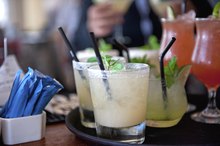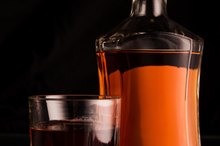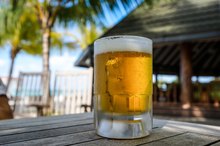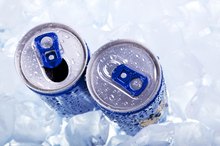Emotional Effects on Children When Seeing Their Parents Drink Alcohol
Drinking in front of children can be a harmless activity as long as the children are taught about the possible hazards involved with alcohol by close, loving parents. Neglect and abuse, however, may lead to troubles for children of drinkers as they grow.
Children of Alcoholics
The most severe emotional problems resulting from seeing parents drink may include guilt, anxiety, embarrassment, the inability to have close relationships, anger and depression, according to the American Academy of Child & Adolescent Psychiatry. This can cause delinquent behavior and abuse of drugs and alcohol later in life. Alcohol abuse can be hereditary, but it can also be related to environmental factors.
Drinking Risks
Causes of Emotional Immaturity
Learn More
There is a link between children who start drinking as adolescents and their parents who exhibited a favorable attitude toward drinking, according to the National Institute on Alcohol Abuse and Alcoholism (NIAAA). Children are more likely to view drinking as harmless when their parents drink, and they start drinking earlier. There is a greater chance they will misuse alcohol by age 17 to 18. Adolescents with fathers who have more than two drinks a day have a greater risk of substance abuse, according to the NIAAA.
- There is a link between children who start drinking as adolescents and their parents who exhibited a favorable attitude toward drinking, according to the National Institute on Alcohol Abuse and Alcoholism (NIAAA).
Peer Association
Teens become more influenced by their peers as adolescents, but they are less likely to drink if they have a close relationship with parents who warn them about the dangers of alcohol. Children of drinking parents tend to associate with peers who have tried alcohol as young as ten, according to the Substance Abuse and Mental Health Services Administration. This also increases their risks of drinking and misusing alcohol early in life.
Monitoring
Emotional Effects of Alcohol Abuse
Learn More
A study by researchers at Virginia Commonwealth University found that parents who drink influence the way their children view drinking as adolescents. The study, published in a 2008 issue of Clinical & Experimental Research, looked at 4,731 adolescents and their parents from data gathered in a Finnish study of health-related behaviors and risk factors. The research revealed that parents who drank alcohol or suffered from drinking problems decreased the monitoring of their children, which led to teenage alcohol use. Although there may have been discipline by the parents, it led to rebellion by youths, suggesting they were more influenced by seeing their parents drink than by their discipline. Parents who communicate with their children at young ages are more likely to see their teenage children view alcohol as harmful and be less likely to drink at ages 17 to 18, according to the Nebraska Substance Abuse and Addiction Services. Lack of communication and monitoring, however, is more likely to lead to adolescents who drink and indulge in heavy drinking.
- A study by researchers at Virginia Commonwealth University found that parents who drink influence the way their children view drinking as adolescents.
- The research revealed that parents who drank alcohol or suffered from drinking problems decreased the monitoring of their children, which led to teenage alcohol use.
Related Articles
References
- ScienceDaily: Parental Drinking and Parenting Practices Influence Adolescent Drinking
- U.S. Department of Health and Human Services. Substance Abuse and Mental Health Services Administration. Behavioral health trends in the United States: Results from the 2014 National Survey on Drug Use and Health. Updated September 2015.
- National Institute on Alcohol Abuse and Alcoholism. The burden of alcohol use: Excessive alcohol consumption and consequences among college students. Updated 2020.
- Chung T, Creswell KG, Bachrach R, Clark DB, Martin CS. Adolescent Binge Drinking. Alcohol Res. 2018;39(1):5–15.
- Jennison KM. The short-term effects and unintended long-term consequences of binge drinking in college: a 10-year follow-up study. Am J Drug Alcohol Abuse. 2004;30(3):659–684. doi:10.1081/ada-200032331
- Meyers JL, Dick DM. Genetic and environmental risk factors for adolescent-onset substance use disorders. Child Adolesc Psychiatr Clin N Am. 2010;19(3):465–477. doi:10.1016/j.chc.2010.03.013
- Adger H Jr, Saha S. Alcohol use disorders in adolescents. Pediatr Rev. 2013;34(3):103–114. doi:10.1542/pir.34-3-103
- Hill SY, Steinhauer SR. Assessment of prepubertal and postpubertal boys and girls at risk for developing alcoholism with P300 from a visual discrimination task. J Stud Alcohol. 1993;54(3):350–358. doi:10.15288/jsa.1993.54.350
- Caspi A, Moffitt TE, Newman DL, Silva PA. Behavioral observations at age 3 years predict adult psychiatric disorders. Longitudinal evidence from a birth cohort. Arch Gen Psychiatry. 1996;53(11):1033–1039. doi:10.1001/archpsyc.1996.01830110071009
- National Institute on Alcohol Abuse and Alcoholism. Alcohol Alert. No.37. Updated July 1997.
- Donovan JE, Molina BS. Childhood risk factors for early-onset drinking. J Stud Alcohol Drugs. 2011;72(5):741–751. doi:10.15288/jsad.2011.72.741
- Reimuller A, Hussong A, Ennett ST. The influence of alcohol-specific communication on adolescent alcohol use and alcohol-related consequences. Prev Sci. 2011;12(4):389–400. doi:10.1007/s11121-011-0227-4
- Chartier KG, Hesselbrock MN, Hesselbrock VM. Development and vulnerability factors in adolescent alcohol use. Child Adolesc Psychiatr Clin N Am. 2010;19(3):493–504. doi:10.1016/j.chc.2010.03.004
- Handren LM, Donaldson CD, Crano WD. Adolescent Alcohol Use: Protective and Predictive Parent, Peer, and Self-Related Factors. Prev Sci. 2016;17(7):862–871. doi:10.1007/s11121-016-0695-7
- Clark DB, Lesnick L, Hegedus AM. Traumas and other adverse life events in adolescents with alcohol abuse and dependence. J Am Acad Child Adolesc Psychiatry. 1997;36(12):1744–1751. doi:10.1097/00004583-199712000-00023
- McClure AC, Tanski SE, Li Z, et al. Internet alcohol marketing and underage alcohol use. Pediatrics. 2016;137(2):e20152149. doi:10.1542/peds.2015-2149
- Windle M. Substance use, risky behaviors, and victimization among a US national adolescent sample. Addiction. 1994;89(2):175–182. doi:10.1111/j.1360-0443.1994.tb00876.x
- Mikosch P. Alcohol and bone. Wien Med Wochenschr. 2014;164(1-2):15–24. doi:10.1007/s10354-013-0258-5
- National Highway Traffic Safety Administration. Lives Saved in 2008 by Restraint Use And Minimum Drinking Age Laws. June 2009.
- National Highway Traffic Safety Administration. Traffic Safety Facts 2008: Young Drivers. 2009.
- Shults Ruth, Elder RW, Sleet DA, et al. Reviews of evidence regarding interventions to reduce alcohol-impaired driving. American Journal of Preventive Medicine. 2001;21(4):66-88.1. doi:10.1016/s0749-3797(01)00381-6
- Substance Abuse and Mental Health Services Administration. Underage drinking.
Writer Bio
Jerry Shaw writes for Spice Marketing and LinkBlaze Marketing. His articles have appeared in Gannett and American Media Inc. publications. He is the author of "The Complete Guide to Trust and Estate Management" from Atlantic Publishing.









